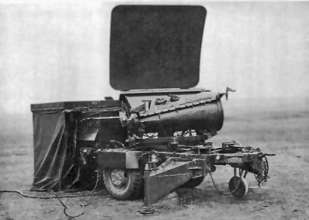AN/MPQ-4
Description of the radar set, tactical-technical characteristics

Figure 1: AN/MPQ-4 radar trailer
 Hersteller:
Hersteller:General Electric
| Specifications | |
|---|---|
| frequency: | 16 GHz
(KU-Band) |
| pulse repetition time (PRT): | |
| pulse repetition frequency (PRF): | 7 000 Hz |
| pulsewidth (τ): | 0.25 µs |
| receive time: | |
| dead time: | |
| peak power: | 50 kW |
| average power: | 285 W |
| instrumented range: | 15 km |
| range resolution: | |
| accuracy: | 50 m |
| beamwidth: | |
| hits per scan: | |
| antenna rotation: | |
| MTBCF: | |
| MTTR: | |
AN/MPQ-4
The AN/MPQ-4 was an operating in KU-Band counter battery radar system used to locate enemy mortars and small artillery units, as well as to correct the fire of friendly mortar and artillery fire. It used a rectangular single curved parabolic reflector fed by a Foster Scanner to scan a required sector of 25 degrees. The transmitter was a self-oscillating magnetron type. The projectile traces were displayed on a B-scope. The radar provided quick identification to pinpoint enemy mortar positions in map coordinates, enabling artillery units to launch counter attacks.
The radar can be set up in less than 15 minutes. All the equipment is mounted on two two-wheel trailers. One trailer carries the primary radar equipment, while the other one carries the primary power supply (a petrol engine generator set) and auxiliary equipment such as the cable set and spare parts.
The radar was introduced in 1958 and remained one of the primary US counter-battery systems into the late 1970s. It has been replaced by the AN/TPQ-36 then. This type of radar was also produced under licence in Japan as the Type 92 mortar locating radar J/MPQ-N1.
